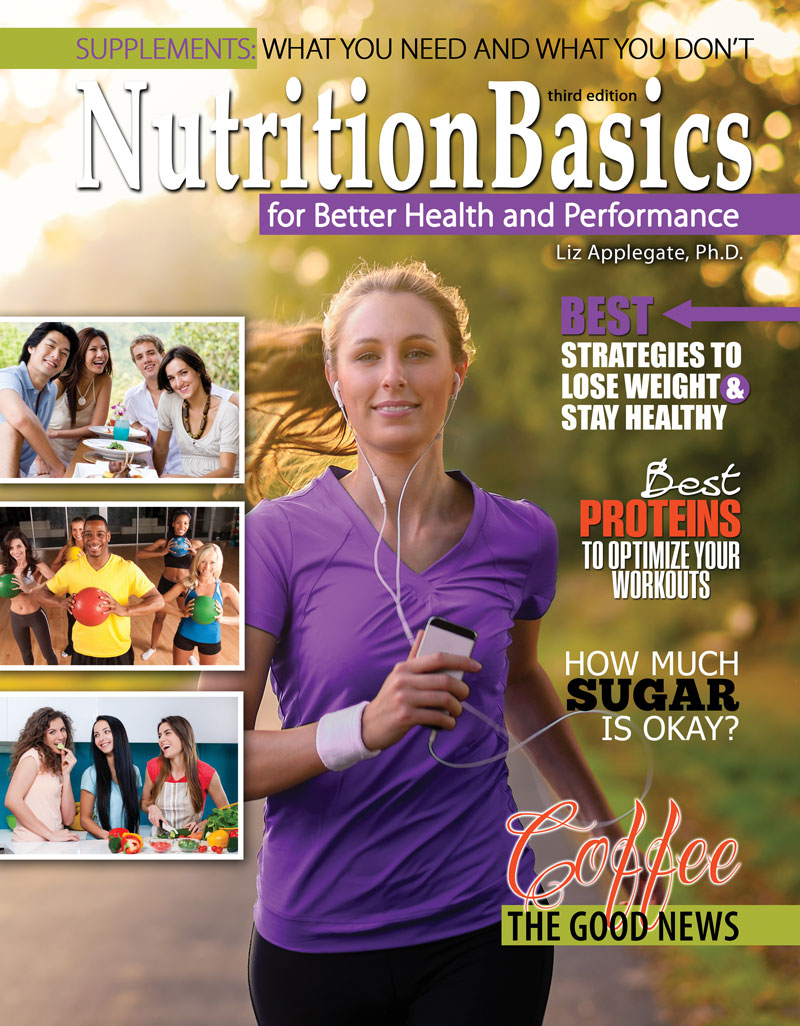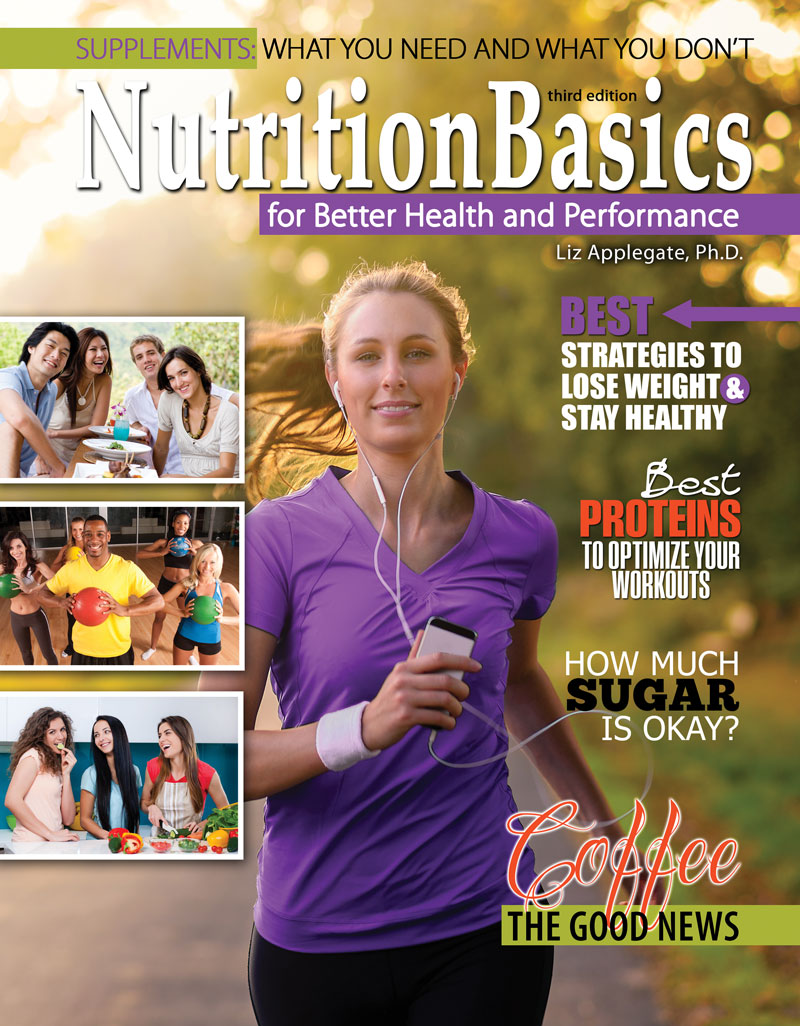Nutrition Basics for Better Health and Performance
Nutrition Basics is a reader for non-major nutrition courses taught at the introductory level. A minimum of scientific terminology is used so the book fits all levels of students. A wide array of nutrition topics are covered from basics about fats, proteins, carbohydrates, and energy metabolism, to popular topics regarding weight loss and supplements. Practical information included also makes this book enjoyable for students and everyone who is interested in improving their health.
Dr. Liz Applegate, a nationally renowned expert on nutrition and fitness, is a faculty member of the Nutrition Department at the University of California, Davis and author of several books including, Encyclopedia of Sports and Fitness Nutrition (Three Rivers Press, 2002). Her enthusiasm and informal style make her undergraduate nutrition classes the nation's largest with enrollments exceeding 2,000 annually. In 1996 she received the Excellence in Teaching Award from the University of California.
Dedication
Acknowledgments
1 Speaking of Nutrition . . . Some Basics
What Are Nutrients, Their Basic Functions, and How Much Do You Need (the RDA)?
How Does Your Body Cope?
Inside Work—The Process of Digestion and Absorption
2 Protein—The Versatile Nutrient
Understanding Protein Structure and Function
Processing Protein in the Body
Protein Defi ciency and Requirement
Making Protein Food Choices
3 Calories—The Energy Basis of Nutrition
Energy Value of Foods
Determining Energy Needs
4 Carbohydrates—The Energy Nutrient
Carbohydrate Structure and Food Sources
Carbohydrate Digestion
Understanding the Power of Fiber
Carbohydrate Energy Metabolism
5 Fat—The Misunderstood Nutrient
The Function of Fat
Fat Types and Food Sources
Essential Fats and Their Role in Health
Fat in Food—Processing
Fat Digestion, Absorption, and Transport
Fat Energy Metabolism
Bringing It All Together—Energy Metabolism
(Protein,Carbohydrate, and Fat)
Cholesterol—Its Vital Roles and Transport in the Body
6 Keep Your Heart Healthy with the Right Foods
The Lipoprotein Story and Heart Disease
Heart Disease Risk Factors—Are You at Risk?
The Role of Diet—Fat, Cholesterol, Fiber, and More
Dietary Recommendations to Reduce Your Risk for Heart Disease
Daily Value for Fat and Saturated Fat and Using Food Labels
7 Obesity, Weight Control, and Eating Disorders—The Facts
Obesity Statistics
Healthy Body Weight—Is Yours
Body Fat Distribution and Fat Cell Development
Food Intake Control
Obesity Causes—Why Energy Balance Becomes Skewed
Weight Loss Options—What Works, What to Avoid
Eating Disorders—Prevalence and Problems
8 Minerals—From Bones to Hormones—The Work
Hard Nutrients
Minerals—Their Origin and Path through the Food Chain
Bioavailability
Major Minerals
Trace Minerals
9 Vitamins—The Wondrous Regulatory Nutrients
Roles and Classification of Vitamins
Water-Soluble Vitamins
Fat-Soluble Vitamins
Do You Need a Vitamin-Mineral Supplement
10 Special Topics That May Save Your Life
Nutritional Impact of Alcohol
Chronic Disease—Cancer
Your Diet, Genetics and Health: Nutrigenomics
11 Nutrition and Athletic Performance
Energy Use During Exercise—Role of Carbohydrate and Fat
Importance of Carbohydrates for Performance and Recovery
Water and Sports Drinks—What’s Best to Drink and How Much
Performance Boosting Aids—What Works and What to Avoid
12 Pulling It All Together—Dietary Guidelines for Americans and Food Labeling
Dietary Guidelines—Principles for Healthy Eating and Physical Activity
Understanding the Dietary Guidelines
Basics of Healthy Eating and Physical Activity Patterns
What Does a Healthy Eating Pattern Look Like
Food Groups
Limits on Certain Food Components as Part of a Healthy Eating Pattern
How Do I “Shift” to a Healthy Eating Pattern
Translating the Dietary Guidelines into Action
Using Food Labels for Healthier Eating
Appendix
Diet Project (with forms
Table of Contents for Food Composition Table
Food Composition Table
Runner’s World Articles
2015–2020 Dietary Guidelines
ChooseMyPlate.gov
MyPlate Dietary Checklist
Dietary Supplements: What You Need to Know
Website References
About the Author
Index
Her enthusiasm for teaching and informal lecture style make her undergraduate nutrition classes the nation’s largest with enrollments exceeding 2,000 students annually (over 50,000 students taught). Her Nutrition 10 course was voted “Best GE Course” in 2008, 2009, and 2010 by the California Aggie, the UC Davis student newspaper. In 2010, Dr. Applegate received the Distinguished Undergraduate Teaching Award. She has also received the Excellence in Teaching Award from the University of California as well as the ASUCD Excellence in Education Award.
Dr. Applegate is the author of several books including Bounce Your Body Beautiful, Encyclopedia of Sports and Fitness Nutrition, Eat Smart, Play Hard, and 101 Miracle Foods That Heal Your Heart.
Dr. Applegate is also on the editorial board of the International Journal of Sport Nutrition and Exercise Metabolism. She is a fellow and past board of trustees member for the American College of Sports Medicine and a member of the Sports and Cardiovascular Nutritionists, a practice group of the American Dietetics Association. She frequently serves as a keynote speaker at industry, athletic, and scientific meetings.
In addition to her university duties, Dr. Applegate writes the popular “Fridge Wisdom” nutrition column for Runner’s World magazine and has written over 300 magazine articles on nutrition and fitness. She is frequently interviewed by national media outlets, including CNN, ESPN, The LA Times, Shape, Self, KCBS Radio, Redbook, ABC News, Men’s Health, and Men’s Journal.
Nutrition Basics is a reader for non-major nutrition courses taught at the introductory level. A minimum of scientific terminology is used so the book fits all levels of students. A wide array of nutrition topics are covered from basics about fats, proteins, carbohydrates, and energy metabolism, to popular topics regarding weight loss and supplements. Practical information included also makes this book enjoyable for students and everyone who is interested in improving their health.
Dr. Liz Applegate, a nationally renowned expert on nutrition and fitness, is a faculty member of the Nutrition Department at the University of California, Davis and author of several books including, Encyclopedia of Sports and Fitness Nutrition (Three Rivers Press, 2002). Her enthusiasm and informal style make her undergraduate nutrition classes the nation's largest with enrollments exceeding 2,000 annually. In 1996 she received the Excellence in Teaching Award from the University of California.
Dedication
Acknowledgments
1 Speaking of Nutrition . . . Some Basics
What Are Nutrients, Their Basic Functions, and How Much Do You Need (the RDA)?
How Does Your Body Cope?
Inside Work—The Process of Digestion and Absorption
2 Protein—The Versatile Nutrient
Understanding Protein Structure and Function
Processing Protein in the Body
Protein Defi ciency and Requirement
Making Protein Food Choices
3 Calories—The Energy Basis of Nutrition
Energy Value of Foods
Determining Energy Needs
4 Carbohydrates—The Energy Nutrient
Carbohydrate Structure and Food Sources
Carbohydrate Digestion
Understanding the Power of Fiber
Carbohydrate Energy Metabolism
5 Fat—The Misunderstood Nutrient
The Function of Fat
Fat Types and Food Sources
Essential Fats and Their Role in Health
Fat in Food—Processing
Fat Digestion, Absorption, and Transport
Fat Energy Metabolism
Bringing It All Together—Energy Metabolism
(Protein,Carbohydrate, and Fat)
Cholesterol—Its Vital Roles and Transport in the Body
6 Keep Your Heart Healthy with the Right Foods
The Lipoprotein Story and Heart Disease
Heart Disease Risk Factors—Are You at Risk?
The Role of Diet—Fat, Cholesterol, Fiber, and More
Dietary Recommendations to Reduce Your Risk for Heart Disease
Daily Value for Fat and Saturated Fat and Using Food Labels
7 Obesity, Weight Control, and Eating Disorders—The Facts
Obesity Statistics
Healthy Body Weight—Is Yours
Body Fat Distribution and Fat Cell Development
Food Intake Control
Obesity Causes—Why Energy Balance Becomes Skewed
Weight Loss Options—What Works, What to Avoid
Eating Disorders—Prevalence and Problems
8 Minerals—From Bones to Hormones—The Work
Hard Nutrients
Minerals—Their Origin and Path through the Food Chain
Bioavailability
Major Minerals
Trace Minerals
9 Vitamins—The Wondrous Regulatory Nutrients
Roles and Classification of Vitamins
Water-Soluble Vitamins
Fat-Soluble Vitamins
Do You Need a Vitamin-Mineral Supplement
10 Special Topics That May Save Your Life
Nutritional Impact of Alcohol
Chronic Disease—Cancer
Your Diet, Genetics and Health: Nutrigenomics
11 Nutrition and Athletic Performance
Energy Use During Exercise—Role of Carbohydrate and Fat
Importance of Carbohydrates for Performance and Recovery
Water and Sports Drinks—What’s Best to Drink and How Much
Performance Boosting Aids—What Works and What to Avoid
12 Pulling It All Together—Dietary Guidelines for Americans and Food Labeling
Dietary Guidelines—Principles for Healthy Eating and Physical Activity
Understanding the Dietary Guidelines
Basics of Healthy Eating and Physical Activity Patterns
What Does a Healthy Eating Pattern Look Like
Food Groups
Limits on Certain Food Components as Part of a Healthy Eating Pattern
How Do I “Shift” to a Healthy Eating Pattern
Translating the Dietary Guidelines into Action
Using Food Labels for Healthier Eating
Appendix
Diet Project (with forms
Table of Contents for Food Composition Table
Food Composition Table
Runner’s World Articles
2015–2020 Dietary Guidelines
ChooseMyPlate.gov
MyPlate Dietary Checklist
Dietary Supplements: What You Need to Know
Website References
About the Author
Index
Her enthusiasm for teaching and informal lecture style make her undergraduate nutrition classes the nation’s largest with enrollments exceeding 2,000 students annually (over 50,000 students taught). Her Nutrition 10 course was voted “Best GE Course” in 2008, 2009, and 2010 by the California Aggie, the UC Davis student newspaper. In 2010, Dr. Applegate received the Distinguished Undergraduate Teaching Award. She has also received the Excellence in Teaching Award from the University of California as well as the ASUCD Excellence in Education Award.
Dr. Applegate is the author of several books including Bounce Your Body Beautiful, Encyclopedia of Sports and Fitness Nutrition, Eat Smart, Play Hard, and 101 Miracle Foods That Heal Your Heart.
Dr. Applegate is also on the editorial board of the International Journal of Sport Nutrition and Exercise Metabolism. She is a fellow and past board of trustees member for the American College of Sports Medicine and a member of the Sports and Cardiovascular Nutritionists, a practice group of the American Dietetics Association. She frequently serves as a keynote speaker at industry, athletic, and scientific meetings.
In addition to her university duties, Dr. Applegate writes the popular “Fridge Wisdom” nutrition column for Runner’s World magazine and has written over 300 magazine articles on nutrition and fitness. She is frequently interviewed by national media outlets, including CNN, ESPN, The LA Times, Shape, Self, KCBS Radio, Redbook, ABC News, Men’s Health, and Men’s Journal.

